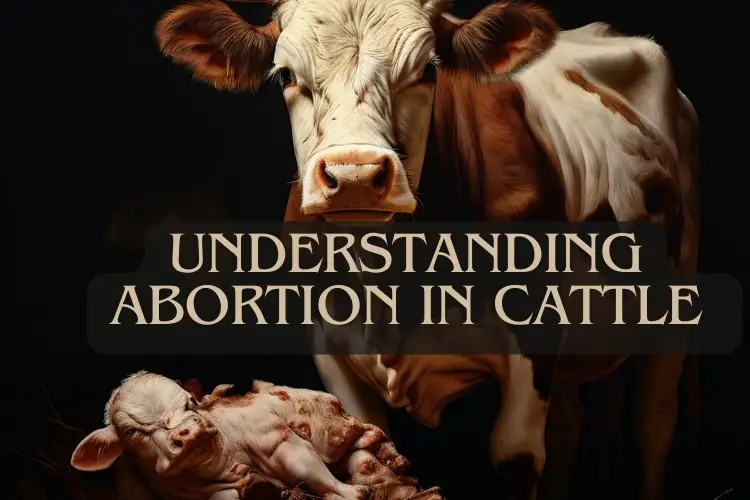Abortion in cattle is a significant issue in the livestock industry, leading to economic losses and animal welfare concerns. Understanding the causes, diagnostic methods, and preventive measures is crucial for managing and reducing the incidence of abortion in cattle herds.
In this blog post guide, we will explore about the etiology, diagnosis, and management of abortion in cattle, along with the adoption of preventive strategies and considerations of ethical and welfare implications.
Key Takeaways
- Abortion in cattle can be caused by a range of factors including infectious agents, non-infectious stressors, and genetic abnormalities.
- Diagnosis of abortion in cattle involves recognizing clinical signs, utilizing laboratory tests, and conducting thorough field investigations.
- Effective management of abortion outbreaks requires immediate response, veterinary intervention, and stringent biosecurity measures.
- Preventive strategies such as vaccination, nutritional management, and selective breeding are essential in reducing the risk of abortion.
- Ethical considerations in handling abortion in cattle encompass animal welfare, the economic impact on farmers, and compliance with regulatory standards.
Etiology of Abortion in Cattle
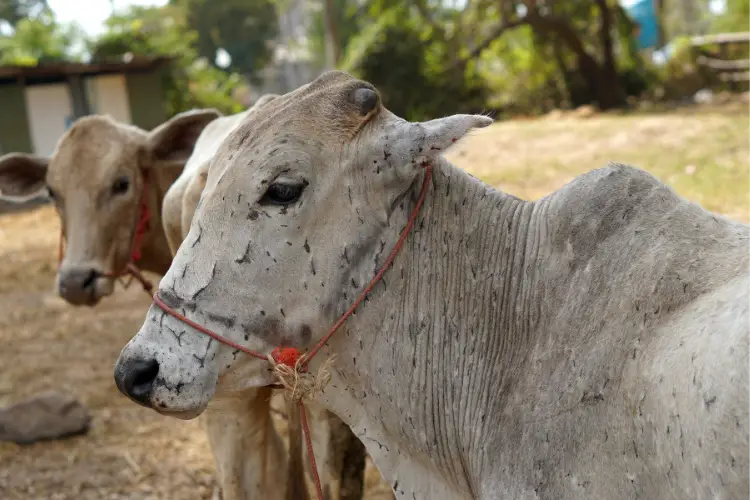
Infectious Causes
Abortion in cattle can be precipitated by a variety of infectious agents, ranging from viruses to parasites. Infectious Bovine Rhinotracheitis (IBR), caused by a herpes virus, is a notable example, often referred to as ‘red nose’ due to its symptomatic presentation.
This condition not only affects the respiratory tract but can also lead to significant reproductive issues, including abortion. Among the parasitic diseases, Trypanosoma species such as T. brucei, T. congolense, and T. vivax are responsible for African Animal Trypanosomiasis (AAT), which can have devastating effects on cattle herds.
The pathogenesis of these parasites varies, with some having the ability to invade mammalian tissue beyond the blood and lymph systems.
Other infectious diseases that contribute to abortion in cattle include:
- Brucellosis
- Q fever
- Bovine tuberculosis
- Anthrax
- Babesiosis
These diseases not only cause direct harm to livestock but also pose significant zoonotic risks, potentially affecting human health.
Non-Infectious Factors
While infectious agents are a well-known cause of abortion in cattle, non-infectious factors also play a significant role. Nutritional deficiencies, environmental stressors, and exposure to toxins can all lead to pregnancy loss.
For instance, inadequate intake of certain vitamins and minerals, particularly selenium and vitamin E, has been associated with increased abortion rates. Management practices can inadvertently contribute to non-infectious causes of abortion.
Overcrowding, poor ventilation, and inadequate sanitation can create stressful conditions for cattle, compromising their immune systems and leading to higher incidences of abortion. It is crucial to maintain optimal living conditions to minimize these risks.
The following list summarizes common non-infectious factors that can cause abortion in cattle:
- Nutritional deficiencies (e.g., selenium, vitamin E)
- Environmental stress (e.g., extreme temperatures, poor housing)
- Exposure to toxins (e.g., mycotoxins, plants, heavy metals)
- Physical trauma or injury
- Hormonal imbalances
Genetic Abnormalities and Reproductive Disorders
Genetic abnormalities and reproductive disorders can significantly impact the reproductive health of cattle, leading to increased incidence risk of abortion. Certain genetic defects are inherited and may result in embryonic or fetal loss.
These defects can be spontaneous or may be passed down from one or both parents, affecting the viability of the pregnancy. Reproductive disorders, on the other hand, may arise from a variety of causes, including hormonal imbalances, structural problems in the reproductive tract, or complications from previous pregnancies.
Early detection and management of these conditions are crucial for improving reproductive outcomes and reducing the incidence of abortion in cattle.
The following list outlines some common genetic and reproductive disorders associated with cattle abortion:
- Chromosomal anomalies
- Defective sperm or ova
- Uterine malformations
- Persistent corpus luteum
- Ovarian cysts
Diagnosis and Detection of Abortion
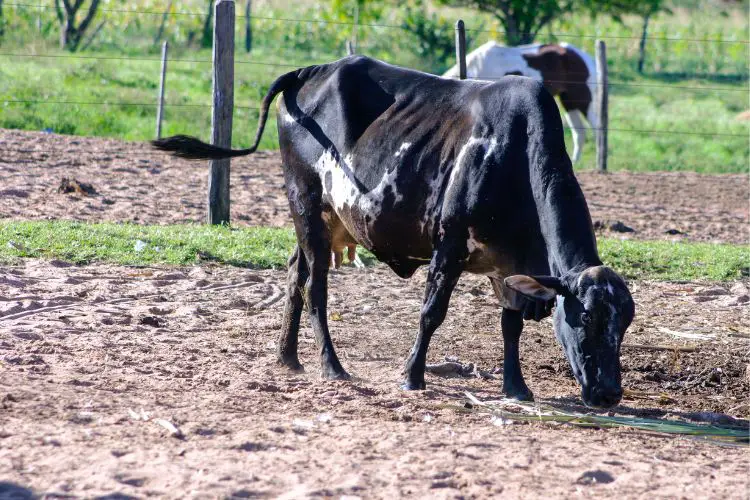
Clinical Signs and Symptoms
Detecting the onset of abortion in cattle is challenging due to the lack of specific clinical signs. Farmers and veterinarians must be vigilant for subtle changes that may indicate a problem. Common symptoms include a sudden drop in milk production, lethargy, and changes in eating behavior.
In some cases, pregnant cows may exhibit signs similar to estrus, which can lead to insemination of already pregnant animals, potentially causing abortion. Immediate veterinary consultation is crucial when these signs are observed.
Clinical examination may reveal additional indicators of abortion. These can range from the presence of vaginal discharge to the observation of fetal membranes or an expelled fetus. Monitoring these signs is essential for early detection and management of potential abortion cases.
Here is a list of clinical signs that may suggest an impending or recent abortion in cattle:
- Decreased milk yield
- Lethargy or depression
- Abnormal discharge
- Retained fetal membranes
- Visible fetus or fetal parts
It is important to note that these signs are not exclusive to abortion and can be associated with other health issues. Therefore, a thorough diagnostic approach is necessary to confirm the cause.
Laboratory Testing and Molecular Diagnostics
The role of laboratory testing and molecular diagnostics in the context of cattle abortion is pivotal. Advanced techniques such as PCR (Polymerase Chain Reaction) are employed to detect the presence of pathogens that may have led to the abortion.
These methods are particularly useful when the fetus shows signs of autolysis, where traditional methods might fail. Molecular diagnostics offer a range of benefits, including sensitivity and specificity, which are crucial for accurate detection.
However, challenges such as environmental factors and cross-reactivity with non-target species can affect the reliability of these tests. It is essential to combine molecular diagnostics with other diagnostic tools for a comprehensive assessment.
The following table summarizes the key aspects of molecular diagnostics in cattle abortion:
| Aspect | Importance |
|---|---|
| Sensitivity | High detection capability for minute quantities of pathogen DNA. |
| Specificity | Ability to distinguish between closely related pathogens. |
| Speed | Rapid results facilitate timely interventions. |
| Sample Type | Compatibility with various sample types, including blood and tissue. |
In conclusion, while molecular diagnostics are a cornerstone in the detection of abortive agents, they should be part of a broader diagnostic approach. The use of different diagnostic tools is highly encouraged for a definitive diagnosis.
Field Investigation and Post-Mortem Analysis
Field investigations and post-mortem analyses are critical components in the diagnosis of abortion in cattle. A thorough examination of the environment where the abortion occurred can provide valuable insights into potential causes.
Factors such as feed quality, housing conditions, and the presence of toxic plants or substances should be meticulously assessed. During post-mortem analysis, veterinarians and pathologists look for anatomical and histological changes that might indicate the cause of abortion.
Tissue samples are collected for further laboratory testing, which may include microbiological cultures and molecular diagnostics. The table below summarizes the common findings and their possible implications:
| Tissue Sample | Finding | Possible Implication |
|---|---|---|
| Placenta | Lesions | Infectious agents |
| Fetus | Malformations | Genetic issues |
| Liver | Necrosis | Toxins or deficiencies |
It is essential to consider environmental factors that may degrade biological samples, such as temperature and UV exposure, which could affect the accuracy of DNA-based diagnostics.
The cost of collecting and processing samples is also a factor, with DNA extraction being a significant expense. However, the investment in detailed field investigation and post-mortem analysis is justified by the potential to prevent future losses through early detection and management of abortion causes.
Management of Abortion Outbreaks
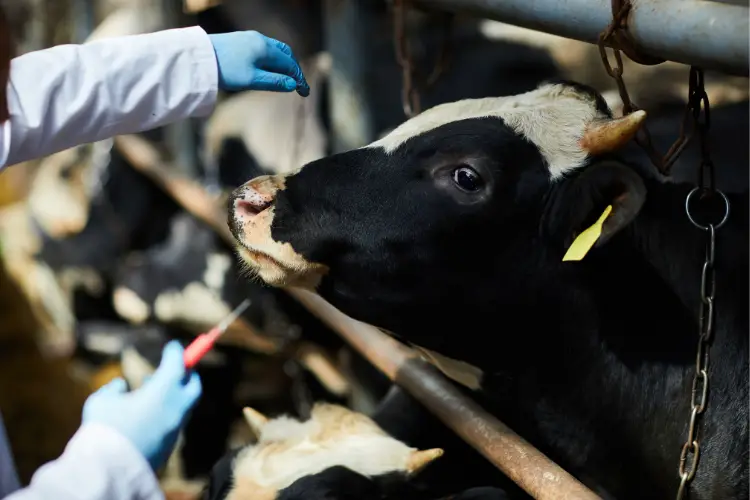
Immediate Response and Containment
When an abortion outbreak occurs in a cattle herd, the immediate response is crucial to prevent further spread. The first step is to isolate the affected animals to reduce the risk of transmitting potential pathogens to healthy cattle. This may involve moving them to a separate area or ensuring that they are not in contact with the rest of the herd.
Following isolation, it is essential to implement strict biosecurity measures. These include disinfecting facilities, equipment, and vehicles that have come into contact with the aborted material.
Additionally, farm personnel should adhere to hygiene protocols, such as changing clothing and footwear before and after handling affected animals.
To assist in identifying disease priorities and informing interventions, it is beneficial to conduct abortion surveillance. This can help in understanding the scope and nature of the outbreak, which is vital for effective containment and management. The table below outlines the key components of an immediate response plan:
| Step | Action |
|---|---|
| 1 | Isolate affected animals |
| 2 | Disinfect facilities and equipment |
| 3 | Implement hygiene protocols for personnel |
| 4 | Conduct abortion surveillance |
It is important to note that confidentiality and privacy issues may arise during the investigation of an outbreak. Farmers and veterinarians must work together to ensure that sensitive information is handled appropriately.
Veterinary Interventions and Treatments
When managing an abortion outbreak in cattle, veterinary interventions and treatments are critical for restoring herd health. Immediate treatment of affected animals is essential to mitigate the spread of infectious agents and to support recovery.
Treatments may vary depending on the identified cause of abortion, which can range from bacterial infections to parasitic diseases such as trypanosomiasis.
Veterinarians may prescribe a combination of antibiotics, anti-inflammatory drugs, and supportive care to address specific infections. In cases of parasitic infections, antiparasitic medications are administered. It is important to follow the prescribed treatment regimen closely to ensure effectiveness and prevent resistance.
The table below summarizes common treatments for various causes of abortion in cattle:
| Cause of Abortion | Treatment Approach |
|---|---|
| Bacterial Infection | Antibiotics, Supportive Care |
| Viral Infection | Antivirals (if available), Supportive Care |
| Parasitic Infection | Antiparasitic Drugs |
| Nutritional Deficiency | Supplementation, Diet Adjustment |
Preventive measures, such as vaccination and biosecurity practices, should be implemented alongside treatments to reduce the risk of future outbreaks. Collaboration with local veterinary services and adherence to treatment protocols are paramount for effective management.
Biosecurity Measures and Herd Health Management
Effective biosecurity measures are essential in preventing the spread of infectious diseases that can lead to abortion in cattle. Regular monitoring and surveillance of the herd’s health status is a cornerstone of these measures.
This includes the implementation of quarantine protocols for new or returning animals, as well as for those showing signs of illness. Isolation of affected animals is crucial to control the spread of infection within the herd.
It is also important to maintain strict sanitation practices, including the disinfection of equipment and facilities. The following list outlines key biosecurity practices:
- Implementation of quarantine protocols for new and returning animals
- Isolation of sick animals from the rest of the herd
- Regular disinfection of barns, equipment, and transport vehicles
- Controlled access to farm areas to prevent contamination
- Training farm personnel in disease prevention and control measures
Maintaining a comprehensive herd health management program is vital for the overall well-being of the cattle. This program should include regular veterinary check-ups, vaccination schedules, and nutritional assessments to ensure that the cattle are in optimal health to resist diseases.
Preventive Strategies and Best Practices
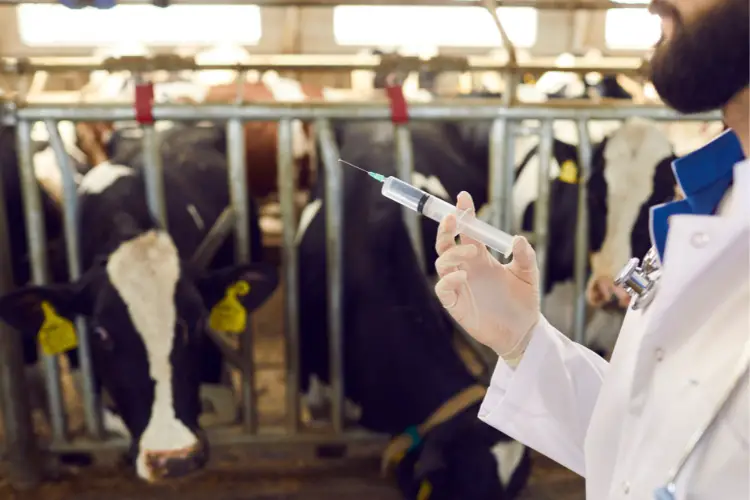
Vaccination Programs
Vaccination is a cornerstone in the prevention of infectious diseases that can lead to abortion in cattle. Effective vaccination programs are designed to stimulate the immune system of the herd, providing protection against specific pathogens known to cause abortion.
For instance, scours vaccines are administered to cows in the late stages of pregnancy to ensure that the highest levels of antibodies are present in the colostrum for the newborn calf. The timing and type of vaccines administered are critical to their success.
A typical vaccination schedule may include vaccines for Bovine Viral Diarrhea (BVD), Infectious Bovine Rhinotracheitis (IBR), and Leptospirosis. It is important to consult with a veterinarian to tailor the vaccination program to the specific needs of the herd, taking into account factors such as local disease prevalence and herd history.
- BVD vaccine: Administered pre-breeding
- IBR vaccine: Given prior to the breeding season
- Leptospirosis vaccine: Often included in pre-breeding protocols
Adherence to a well-planned vaccination schedule can significantly reduce the incidence of abortion in cattle, safeguarding the health of the herd and the investment of the farmer.
Nutritional Management and Supplementation
Proper nutritional management is crucial for preventing abortion in cattle. Adequate mineral and vitamin supplementation can play a significant role in supporting reproductive health. For instance, dietary iodine is essential for thyroid function, which is closely linked to reproductive performance.
Supplement sources for iodine include calcium iodate, ethylenediamine dihydroiodide (EDDI), potassium iodide, and sodium iodide. It is important to tailor the supplementation program to the specific needs of the herd, considering factors such as forage quality, stage of production, and breed-specific requirements.
A balanced diet not only prevents nutritional deficiencies but also enhances the overall immune competence of the cattle, reducing the risk of abortion due to infections.
To ensure effective supplementation, farmers should work closely with a veterinarian or a nutritionist to develop a comprehensive plan. This plan should include regular monitoring of the herd’s nutritional status and adjustments to the diet as necessary.
Breeding Strategies and Genetic Selection
In the realm of cattle reproduction, strategic breeding and genetic selection play pivotal roles in reducing the incidence of abortion. Careful selection of breeding stock can mitigate the risk of genetic abnormalities that may lead to reproductive failures. It is essential to consider the genetic history and health records of potential breeding animals.
Genetic selection involves identifying and promoting traits that enhance fertility and embryonic survival. For instance, selecting for cows with a history of successful pregnancies can be beneficial.
It has long been known that cows bred when they are gaining weight (increasing body condition score) have higher pregnancy rates than cows bred when they are losing weight. This insight should be integrated into breeding programs to optimize outcomes.
Effective breeding strategies may include:
- Synchronized breeding to ensure optimal mating times
- Use of sexed semen to produce the desired gender
- Implementation of embryo transfer techniques to maximize genetic potential
By combining these approaches with ongoing research and technological advancements, producers can significantly improve herd fertility and reduce the likelihood of abortion.
Ethical Considerations and Welfare Implications

Animal Welfare Concerns
The welfare of cattle is paramount in the context of abortion management. Stress and discomfort associated with abortion can significantly affect the well-being of the animals. It is essential to ensure that all procedures and interventions comply with established animal welfare guidelines, such as the ARRIVE guidelines and the Animals (Scientific Procedures) Act.
In the case of diagnostic procedures, it is crucial to minimize the distress caused to the animals. Traditional methods, like blood sampling, require restraint and can be invasive, leading to potential injury and stress. Therefore, the development of less invasive diagnostic techniques is a key area of focus to enhance animal welfare.
Economic losses due to abortion in cattle are not just a financial concern but also reflect the broader impact on animal health. Abortion can lead to a cascade of health issues, including:
- Acute anaemia
- Weight loss
- Decreased milk and meat yields
- Reduced fertility
These health issues not only affect the productivity of the herd but also the quality of life for the individual animals. It is the responsibility of the farming community and regulatory bodies to ensure that the welfare of cattle is not compromised in the pursuit of agricultural productivity.
Economic Impact on Farmers
The repercussions of cattle abortion extend beyond the immediate loss of offspring. Farmers face a multifaceted economic impact, with reduced productivity manifesting in several ways. For instance, there is a notable decrease in milk and meat yields, which are primary sources of income for livestock owners.
Additionally, affected cattle often exhibit diminished fertility and a decreased capacity for agricultural work, further compounding the financial strain on farmers.
The economic burden is not limited to individual losses but also affects the broader agricultural economy. In sub-Saharan Africa, for example, Animal African Trypanosomiasis (AAT) is a significant cause of morbidity and mortality in ruminants, leading to an estimated annual loss of US$4.5 billion.
This staggering figure underscores the importance of addressing livestock abortions not only for animal welfare but also for the sustainability of farming livelihoods.
Financial considerations play a pivotal role in decision-making related to livestock management. The necessity for stable finances is evident, as the economic burden of livestock abortions can lead to difficult choices for farmers, especially in low and middle-income countries where the economic impact has not been thoroughly estimated.
Regulatory and Legal Framework
The regulatory and legal framework surrounding abortion in cattle is complex, involving various laws and guidelines that aim to balance animal welfare, farmer interests, and public health concerns. Confidentiality and privacy issues often arise, particularly in relation to the handling of sensitive data during outbreak investigations.
Compliance with existing regulations, such as the Animals (Scientific Procedures) Act and ARRIVE guidelines, is mandatory for research and diagnostic activities. These laws ensure that animal welfare is not compromised and that ethical standards are maintained.
Moreover, the legal framework is designed to prevent barriers to the autonomy of decision-making and accessibility of healthcare services for animals.
Policies set by organizations like the National Cattlemen’s Beef Association reflect the industry’s stance on fairness and support for new entrants. For instance, they oppose farm policy that favors certain producers and advocate for opportunities that encourage young individuals to join the beef cattle business.
Conclusion
In conclusion, understanding abortion in cattle requires a multifaceted approach that encompasses both the biological causes and the socio-economic factors influencing the decision-making process.
The complexity of the issue is mirrored in the diverse range of causes, from molecular diagnostic challenges to the socio-economic pressures faced by young women in restrictive settings. Preventive measures must therefore be equally comprehensive, addressing not only the veterinary and husbandry practices but also the broader social determinants of health.
It is imperative that interventions are evidence-based and that aftercare is readily available to ensure the safety and well-being of both the animals and those involved in their care. As we continue to advance our knowledge and refine our practices, the goal remains to minimize the incidence of abortion in cattle while respecting the ethical considerations and the realities of those affected by this issue.
FAQs:
What are the most common infectious causes of abortion in cattle?
Common infectious causes include Bovine Viral Diarrhea (BVD), Brucellosis, Leptospirosis, Neosporosis, and Infectious Bovine Rhinotracheitis (IBR).
How can farmers detect the early signs of abortion in their cattle?
Early signs can include vaginal discharge, premature expulsion of the fetus, or the cow showing signs of illness such as fever, lethargy, or decreased appetite.
What immediate steps should be taken during an abortion outbreak in a cattle herd?
Immediate steps include isolating affected animals, notifying a veterinarian, implementing strict biosecurity measures, and beginning a thorough investigation of the cause.
How can vaccination programs help in preventing abortion in cattle?
Vaccination programs can prevent abortions by protecting cattle against specific infectious agents known to cause abortion, such as BVD and Brucellosis.
What role does nutrition play in the reproductive health of cattle?
Proper nutrition is crucial for maintaining a healthy reproductive system. Nutritional management and supplementation can help prevent abortions by ensuring cows receive adequate vitamins and minerals.
What ethical considerations arise in the management of abortion in cattle?
Ethical considerations include the welfare of the animals, the use of humane treatment methods, the economic impact on farmers, and adherence to regulatory and legal frameworks governing animal health.

